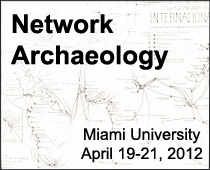Presentation by Peter Schaefer (Marymount Manhattan College).
This paper uses a comparative analysis of published appearances of “ether” by computer scientists in the 1970s and physicists in the 1880s. In 1973, at the Xerox Palo Alto Research Center (PARC), computer scientists created a prototype for the Ethernet, what would become the most prevalent system for connecting local area networks. At that time the Ethernet consisted of several computers linked via a series of coaxial cables, and these cables the scientists referred to as the “ether.” Why is “ether” in the “Ethernet”? The term “ether” carries with it a vexed history from the perspective of natural science. Physicists in the 19th century referred to “ether” as the substance through which electromagnetic energy traveled. Before the publication of the theory of special relativity in 1905, many physicists worked to find mechanical models that explained electromagnetism in a way that fit with Newtonian physics. Ether was central to these modeling efforts, since electromagnetic energy must travel through a physical substance in keeping with the tenets of classical mechanics. Ether was thought to be everywhere yet invisible. Despite numerous attempts, the existence of the ether was never verified through experiments, and as the paradigm shifted, the word “ether” disappeared from theories of electromagnetism only to be picked up as a signifier for radio and television waves. When explaining their use of “ether,” the scientists at the Xerox PARC state that they intended to invoke the usage by 19th century physicist, not the 20th century use with broadcasting technology. What does the redeployment of “ether” tell us about how computer scientists viewed early network infrastructure? When old terms are used to refer to new types of digital technology, these words carry with them vestiges of their previous use, as argued by Tarleton Gillespie, Lev Manovich, Ben Peters, and many others. This paper argues that a transcendental hope for universal access to communication networks shaped the naming of Ethernet and its constituent parts. This analysis sheds light on contemporary misconceptions of internet infrastructure, particularly the idea that network infrastructure is universal and immaterial much like the conception of ether by Victorian-era physicists.
Peter Schaefer is Assistant Professor of Communication Arts at Marymount Manhattan College. His work has appeared in the journals Critical Studies in Media Communication and New Media & Society as well as in the anthologies The Long History of New Media: Technology, Historiography, and Newness in Context and iPod and Philosophy.



